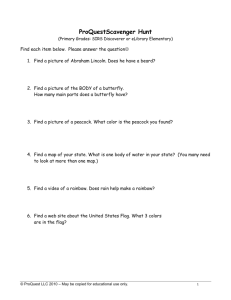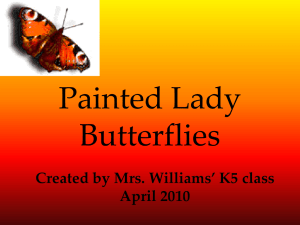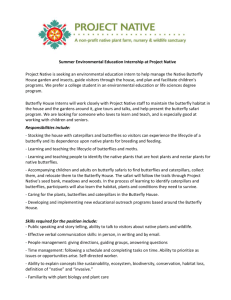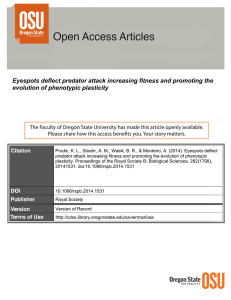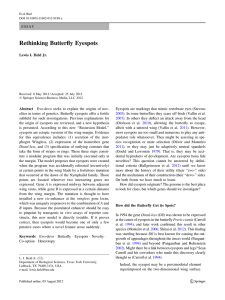Nature of Science Guided notes Butterfly
advertisement
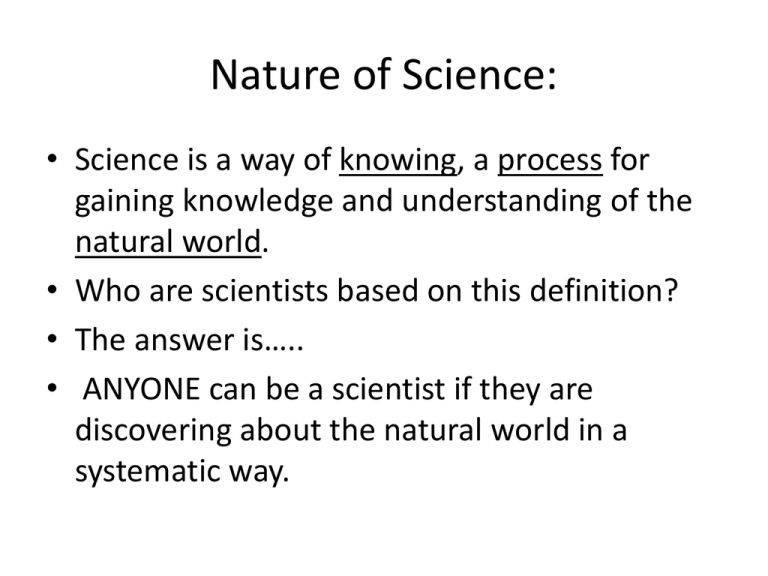
Nature of Science: • Science is a way of knowing, a process for gaining knowledge and understanding of the natural world. • Who are scientists based on this definition? • The answer is….. • ANYONE can be a scientist if they are discovering about the natural world in a systematic way. Nature of Science Discussion • Take some time and determine whether or not you can qualify being a scientist. Please write down why you can be a scientist even though you are an 8th grade student. • Name someone in your family or who is close to you, that is a scientist and why. – Remember, if they are finding out about the world in a systematic way, then they are a scientist. Nature of Science: • Each science process is unique depending on: 1) what is observed and 2) how scientists modify (change) their conceptual models and their experiments. • Mrs. Walker will show you one scientific method that as we go through this scientific process. (These slides are in a different color so you know not to write notes on these slides.) • Here are some of the processes in a scientific investigation: Form a research question. • Sometimes when we observe something in the natural world we may have many questions. However, when we want to collect data to find out our answer, we choose one question so we test one question at a time. How do peacock butterflies avoid being eaten? Main Points from the research conducted before the experiment: Peacock butterflies are eaten by birds They are camouflaged with wings closed but open wings to show bright “eyespots” when threatened The butterfly wings make a variety of noises as they open Some of the birds do not eat the butterflies after the butterflies open their wings Discuss possible outcomes of investigation • Both of these steps would include; • Researching on the topic and – Which I discussed I did in the last slide. • Creating a model. – I came up with a visual way to show what I thought. – What one ends up deciding to test on is considered the Hypothesis. Identify variables. • A variable is anything that can change the experiment. • There are three different variables. – Independent variable: what you test. – Constant variables: what is not tested is kept the same between test groups. – Dependent variable: the results (how it is measured) • Control groups: sometimes occur if one wants to compare what would normally happen. A control group is the norm. ~ Try to determine in your groups what the variables are in my experiment. Variables Independent Variable- Butterfly characteristic (noise, eyespots, both) Constant Variables- Type of butterfly, type of predator, time since predator’s last meal, time of day, approximate size of butterfly Dependent Variable- Result of predator/butterfly interaction (Did the butterfly get eaten?) Experimental Groups Butterfly with Eyespots Painted Over Butterfly with no eyespots or noise maker Butterfly with noise maker removed Plan procedures to control independent variable • As much as to the extent possible, plan to control the constant variables and only test one independent variable. – The experiment I’ve shown was tricky to control, they had to make sure the paint didn’t affect whether or not the butterflies were eaten and that the predators and butterflies were as similar to each other as possible! Experimental Groups (Top) and Control Groups (bottom) Collect data on the dependent variable. • You should know ahead of time how you will be collecting the data. • Then when the experiment is occurring you will be prepared to record the data as it comes. – If you choose to record something that happens during your day, you need to record it – Example: time between meals and stomach rumbles Data Select appropriate format to summarize data obtained. • Some ways that you can analyze the data appropriately are through: – Graphs – Charts – Diagrams • Etc. Results Analyze data and construct reasonable conclusions. • Think about what worked and what didn’t work before coming up with a main statement. • Many scientists must say that data was inconclusive (meaning it didn’t work)… but this gives them the chance to change their experiment and try again. • - This whole process relies on inference: which is to make a strong assumption based on the data that is collected. Conclusion Eyespots provide peacock butterflies with the effective defense against bird predators. Sound made by the butterfly’s wings does not seem to be as important as the eyespots in startling predators. Prepare written and oral reports of the investigation. • Include questions, models, experimental plan, data, graphs etc. … • It may also include limitations of the study, what needs to be improved, and a revised model. Which Laundry Detergent is Best? Mitchell Stone 3rd Hour Hypothesized Result and Why TYPES OF DETERGENT Will work Best Higher Cost Popular Brand Will work 2nd Best Also a popular brand Higher Cost Works 3rd Best Lower Cost Not as Popular Will work the Worst Lower Cost Not seen as Frequently Stains, Material of Towels, Amount of Detergent, Water Temperature, Time of Agitation CONSTANT VARIABLES Using 4 different detergents INDEPENDENT VARIABLES Stain Makers Stains applied to Towels How well the Stains come out DEPENDENT PROCEDURES OF CONTROL 1. 2. 3. 4. 5. 6. 7. Apply stains to towels & allow to dry Measure ½ cup detergent Add water at 125o F Soak for 1 minute then Agitate for 2 minutes in closed container Wring out excess water Repeat steps 2-5 twice per detergent Record results in a data table Procedures of Control Results of Procedures Results of Procedure Results of Procedure Results of Procedure Model: • She should have a model of what she thinks would work and why Select an Appropriate Format • Her data would be much more understandable if she created a graph on which treats were selected the most (the number of times). After The Three Trials, I Concluded That Each Dog Preferred A Different Treat Each Time, But Their Choices Were Much Different Than The Others. Science Experiment By Kurt Olsen Topic of Interest: Boiling Water Investigation Question: Does the Altitude affect the Temperature at Which Water Boils? Hypothesis: My hypothesis is that if the water is boiled closer to sea level, then the temperature at which the water will boil will be hotter. (Lower Elevation means Hotter Temperature) Possible Outcomes as a Model Experiment 1. Boil water in a pot. 2. Take the temperature of the water. Control/Constant Variable: I used only water and the same amount of water. - Same kind and size of pot. Independent Variable: The different altitudes at which the water is brought to a boil. Dependent Variable: The temperature at which it boils At sea level the water boiled at about 212°F. At about 4500 ft. above sea level the water boiled at 203°F. Results: 212 210 208 Sea level 4500 Ft. 206 204 202 200 198 Boiling Point Conclusion: My hypothesis was correct. The closer to sea level, the hotter the water is when it boils. That is because at sea level, there is more air pressure pushing down on the water then there is at 4500 ft. above sea level. The air pressure makes it harder for the water to boil.

